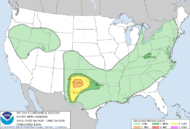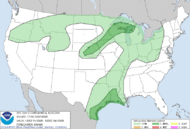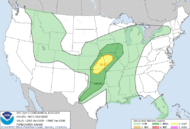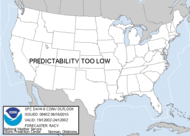- Longest track tornado in AR history (123 miles)
- Dewpoints were not that high, in mid 50's to lower 60's
- 110 kt jet stream over Springfield, MO
- Helicity max was in eastern AR
- Most tornado deaths in AR since 3-1-1997
- Most fatalities since the 4/2/06 outbreak
- Terminal Doppler Radar in Hernando, MS helped them see things at a lower level than NEXRAD due to proximity to storm and showed an anticyclonic flare echo at 500' off the surface
- Shelby County tornado was captured on video, including live on News Channel 3.
- NWS used "tornado emergency" wording
- NWS evacuated its office between 5:45 and 6
- Nashville NWS backed up because primary backup Little Rock was issuing tornado warnings
- The fact that there were no fatalities in the EF4 at Union University "nothing short of a miracle"
- Hardin County police chief survived by hanging on to his commode
- First ever F/EF 4 tornadoes in North Alabama recorded in February
- First North Alabama EF4 or greater since Anderson Hills Tornado 5/18/95
- MESH data from NSSL showed tracks of hail which represents supercell tracks well
- At midnight (3 hrs before Lawrence Co EF4), Huntsville set a record high of 70
- Helicity was very high, CAPE was high, but not unusually high
- Lawrence Co is 60 mi from Columbus and 65 from Hytop NEXRADS
- NWS used ARMOR radar, about 25 miles away saw storm at 1700'
- Report of damage in Beaverton in Lamar was critical for this warning to being issued!
- Tornado lifted at Decatur City limits, sparing area from major damage, injuries, and death
- 2nd supercell over Cullman may have choked off inflow as Lawrence Co tornado lifted
- Jackson Co tornado was slightly stronger, with winds of 180 mph
Brian has been in meteorology for 42 years and has surveyed storms for 40 years but he saw things he had never seen before in Lawrence County, AL, Jackson County, AL, and Hardin County, TN. He was called in as a member of the elite QRT (Quick Response Team) which is responsible for making the final determination of all EF4 and EF5 tornadoes. Tornadoes in all three of the counties mentioned above were rated EF4 by the QRT. Click on the links for Brian's photos. Some of the things he saw included:
- 2500 pound hay bales (on the edge of the tornado) in Jackson Co. tossed around like toys
- 15" cone dug out around a telephone pole as the tornado moved the pole back and forth
- An unanchored house was thrown over 300'
- A car was thrown over 450' and was crumpled up like a piece of paper
- There were a series of gouges in the ground that indicated the car was thrown in an arc
- Large tree was uprooted and the root ball (twice as tall as a man) was rotated
- Mud plastered to a house was so thick that it literally changed the color of the house
- Lawrence Co man described a "humming" noise, possibly from high voltage power lines
- Another Lawrence Co man felt his house "quiver", then it was turned around
- Yet another Lawrence Co man felt his house "bounce" three times, then he had to suddenly swim for cover. His house was deposited in a pond 500' away
- One family survived as a boat, a boat motor, and a four wheeler slammed into their house
Many studies have suggested that the tornado database is biased by the concentration of human observers. Some studies have shown that a possible 66% decrease in tornado activity can be directly attributed to population density. This study examines whether or not such biases exist throughout the United States. Population and population change data are compared to the historical tornado database in order to better understand the relationship(s) between each variable. Various statistical and spatial techniques are implemented in order to better identify relationships. As expected weak (F0-F1) tornadoes show the greatest correlation to population patterns, including travel routes. However, not all regions of the United States show the same biased pattern in similar time periods and therefore any meaningful adjustment to tornado climatologies should not anticipated.
- Frequency of tornadoes has increased at the same rate as the rate of population increase
- Twice as many tornadoes have been reported near interstate highways in the US as in areas away from interstates
- More tornadoes are reported near cities than in rural areas
- Differences are greater in western states than in eastern states
- Despite biases in research, this is an interesting study that needs further research
- NEXRAD enhanced probability of detection but has not reduced false alarm ratio (FAR)
- 4 out of 5 tornado warnings do not have tornadoes reported
- FAR's include: AL .838, GA .835, TN .844, MS .832
- High FAR's seem to be associated with areas that are heavily forested
- Much more research is needed before any conclusions can be drawn
- The left exit region (front) and right entrance (rear) regions of a strong jet stream (> 90 knots) are the most likely regions for significant tornado development
- Numerous case study maps were shown that indicate that tornado outbreaks usually occur just to the east of the main jet stream
- Models underestimated the snow and predicted it too far to the north
- Heavy rain changed to heavy snow, resulting in 4-5" in Covington Co., SE of Jackson
- Temperature lowered to freezing, not due to cold air advection, but rather due to vertical advection (adiabatic) and diabatic (melting) effects
- 14 fatalities occurred in the Memphis CWA due to the heat (83 in the heat wave of 1980)
- Drought influenced the heatwave as soil and vegetation were much drier than usual
- Jackson, TN set an all-time record high of 106
- Memphis had 13 days over 100; Jackson, TN had 17 days over 100
- Consecutive days >95: Jackson, TN=31, Memphis=28, Tupelo, MS=25
Dana worked at the NWS in Slydell, Louisiana during Hurricane Katrina. He gave the most emotional and moving account of the entire conference. He described his feelings as "sickening" as he relived the "surreal" and terrible event with emotion in his voice. He described the impact the hurricane had on his family as well as the NWS office where he worked. This was the first time he has spoken publicly about his experience. His family lived in Diamondhead, MS, on the northern shore of St. Louis Bay. He had evacuated his family to Memphis well prior to Katrina's landfall. The forward eyewall passed directly over Diamondhead, which was the highest elevated portion of the coast. He said that I-10 acts as a levee and that the corps of engineers said that the area was safe from flooding.
As he drove back toward his home, he saw a four lane highway, 5 miles inland, that had turned into a raging river. The few trees that were left standing were scarred and full of debris. As he approached his home he felt as if he were "driving through someone's living room" because of the furniture that was scattered about. Many people placed plywood signs in the front of their homes with the mane of their insurance company on it.
Power was out in Diamondhead for two weeks. Water and sewer service was out for one week. People had to become "creative" in ways to use the bathroom. It was over a week before gas stations opened and people camped out in order to get in line for gasoline. Insurance rates almost doubled, rising by 90 per cent.
He said that even today you can drive along US 90 and see where concrete slabs are all that remain where houses once stood. He said that many people did not have flood insurance because "experts" had told them that they were in an area that could not flood.
He indicated that he struggles with bitterness. He does not understand why his office kept working during this hurricane. He described his feelings about working while the roof of the Slydell NWS was "dancing". The saddest part was when after the event he listened to recordings of 911 calls. Most of the calls were people who were crying helplessly as water was pouring into their homes and the only response they were given was, "We cannot help." The saddest call was from a person who said, "I just want you to know that my mother and I are fixing to die. Please tell our family that we love them."
WRF Ensembles - Gregory Garrett - NWS Jackson
Gregory showed how this model did a great job predicting severe parameters and convective development in the 24 hours preceding tornado outbreaks this year. He said that at this time this is only available for his office but he is working to get it on a public server and to increase the resolution.
Cool Season Tornado Events - Brad Bryant - NWS Jackson
Brad showed that in the AR, LA, and MS areas the tornado threat during the cold season (Dec 15 through January 31) is doubled during well-expressed La ina modes.
Cool Season Tornadoes in the Southeast United States - Steve Nelson - Peachtree City NWS
- Low instability during the cool season does not equate to no chance of tornadoes
- F2 or greater tornadoes must have high levels of shear to develop
- Tornadoes cause the majority of storm related damage and deaths during the cool season
- Tornadoes are more likely to persist overnight during the cool season than in the spring
- Mean level CAPE during cool season F2 events is 1300 j/kg
- Helicity values are at least 200-250 m/s during the cool season events
- CAPE values are often less than 100o j/k during cool season events
- Lightning output is low in cool season events










No comments:
Post a Comment